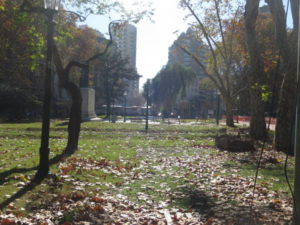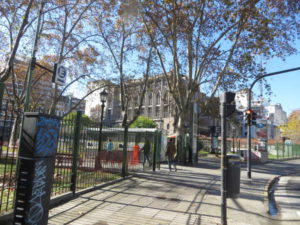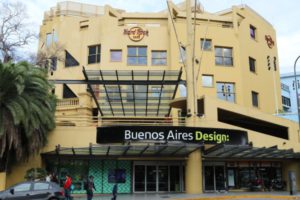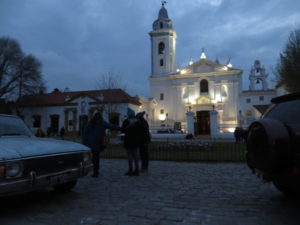The Recoleta Neighborhood of the Sunny Recoleta Apartment!
Recoleta is one of the most exclusive areas in Buenos Aires, where both history and charm get together, in its wide cultural circuit, with its museums, galleries, parks and gardens.
Map of the Recoleta Neighbourhood
Neoclassical French influence on Recoleta’s architecture:
Recoleta´s architecture is signed by the neoclassical French influence, which had begun on the second half of the XIX century, when the aristocratic families from BS As who lived in the southern areas decided to relocate in this lands in a attempt to escape from a flu epidemic.
Therefore, since 1871 several luxurious residences were built in this area, giving its landscape an European resemblance.
A short history of the Recoleta Neighborhood:
Translated from the following page http://www.barriorecoleta.com.ar/historia-recoleta.html
“When Juan de Garay founded Buenos Aires for the second time in 1580, he divided the land between the 65 people who were with him. Only 6 of the 65 areas were located in what it is today known as the Recoleta neighbourhood. Today’s central Recoleta zone had been given to Rodrigo Ortiz Zárate, who created a farm called “Los “Los Ombúes”es”, because of the “Ombú” plants in that land.
After Rodrigo Ortiz de Zárate died, the land was inherited by Juan, his eldest’s son, who sold the land to the french captian Beaumont, in exchange for a suit, because thought that the land had no value whatsoever. In 1608, captian Beaumont sold the land in exchange of a pair of tongs, a wig, and a coat. Paradoxically, today Recoleta is one of the top premium zones in Buenos Aires.
The land changed hands many times, till in the XVIII century, a couple donated the land to the order of the “frailes Recoletos descalzos de la Congregación Franciscana“, a catholic monk order, who built a convent and the church “Nuestra Señora del Pilar“. The name “Recoleta” comes from the convent and church began in 1706 and finished in 1732.
The Recoleta Cemetery began at the same time that the church was started to build. President Rivadavia expropriated the cemetery, and it was called “Northern cemetery”. And when Torcuato de Alvear was major of the city of Buenos Aires, a new entrance to the cemetery was built.
In the 1870’s a yellow fever and cholera epidemic struck Buenos Aires, so the population spread out to avoid infection. The low and popular classes moved southwards, but the rich people chose Recoleta, because the land was high enough to reduce the number of insects transmitting these diseases.
These rich families built huge french style houses and mansions, surrounded by parks and gardens, with elements brought from Europe. Some say that Recoleta is a bit of Paris brought to Argentina: big green parks, exclusive avenues, and streets with bars, and premium restaurants.
The evolution of the Recoleta neighbourhood was very fast: during the XVIII century it was only plain land, a hundred years later there were some villas. Half a century later, the villas were replaced by the rich huge houses and mansions that made Recoleta one of the top premium Buenos Aires neighbourhoods. Today, some of these mansions coexist with modern apartment buildings.
Plaza Teniente General Emilio Mitre
This plaza is located only one block away from the apartment. Many buses and the H subway / underground station are located on the this plaza.

The H subway line links with other subway lines. Here is a picture of the entrance, located just two blocks away from the apartment, on the intersection of Pueyrredon and Las Heras avenues:




There is a very important underground car parking garage:


The “ecobici” systems by the Buenos Aires city government lends bicycles to anywone for free. The requisite is to insert the personal identification document data (DNI). Here is a picture of one of the depots, this one is located on the Teniente General Emilio Mitre plaza.

Plaza Gelly y Obes known as “La Isla”
Just two blocks and a half away from the apartment you may walk through “La Isla” around the Gelly y Obes plaza. The place is also known as “The little Paris”, because of the neoclasical french architectonical building style.








Plaza Mitre
This plaza remembers Bartolome Mitre, who was president of Argentina during 1862-1868.





Museo Nacional de Bellas Artes – National Gallery



Plaza Francia



Plaza Intendente Torcuato de Alvear and Plaza Francia flea market
This plaza is sometimes seen as a continuation of Plaza Francia, but officially is known as Plaza Intendente Torcuato de Alvear.





Buenos Aires Design













Centro Cultural Recoleta (Recoleta Cultural Center)





Basilica of Our Lady of the Pillar (Catedral-Basílica de Nuestra Señora del Pilar)
One of the oldests churchs in Buenos Aires, by the Recoleta cementery.




Nuestra Señora del Pilar Church by night


La Biela bar and other restaurants



Recoleta Cementery (Cementerio de la Recoleta)



Village Recoleta, restaurants, pubs and cafes near the apartment:






